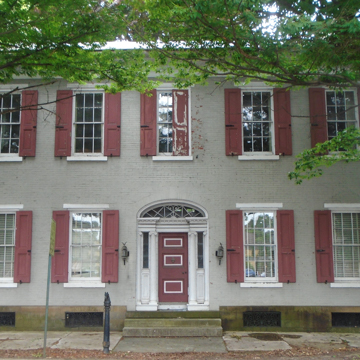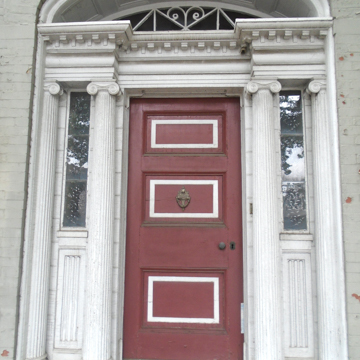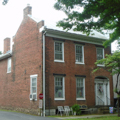After 1833 when the west branch of the Pennsylvania Canal pushed through Muncy to Williamsport, it had an immediate effect on the town's architecture. Benjamin Pott's two-story brick house is a blend of the locally favored Federal style, Greek Revival, and details that apparently were his own. The Federal style is evident in the Flemish bond, gable lunette, and elliptical fanlight, and the most salient Greek Revival features are the Ionic entrance and the cornice's Greek key pattern. The iron lintels of the windows and the corner blocks, Pott's apparent contribution, are cast in a floral pattern. Pott was a son of the founder of Pottsville, Schuylkill County, where in 1828 he inherited his father's house, furnace, and forge and more than seventy acres. He and his brother built a sawmill and another furnace and forge here, near the newly completed Schuylkill Canal, and this forge was the likely source of his house's iron lintels. Pott probably built the house shortly after he married Sarah Shoemaker of Newberry (now part of Williamsport) in December 1836. As a carpenter and cabinetmaker, Pott made a number of entrance frontispieces for buildings in the area and presumably crafted this one for his own house. Another can be seen on the Clapp-Wood House (1855) at 26 N. Main Street; it was made for another dwelling and moved here in the 1940s. A small front porch was removed from the Pott House after 1940 when the soft local brick could no longer support the brackets. Pott's workshop, hidden under later additions, survives on the house's south side.
You are here
Benjamin Pott House
If SAH Archipedia has been useful to you, please consider supporting it.
SAH Archipedia tells the story of the United States through its buildings, landscapes, and cities. This freely available resource empowers the public with authoritative knowledge that deepens their understanding and appreciation of the built environment. But the Society of Architectural Historians, which created SAH Archipedia with University of Virginia Press, needs your support to maintain the high-caliber research, writing, photography, cartography, editing, design, and programming that make SAH Archipedia a trusted online resource available to all who value the history of place, heritage tourism, and learning.












